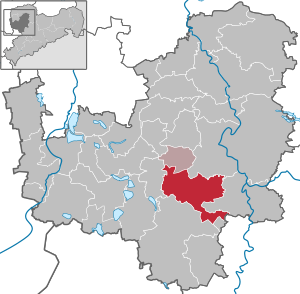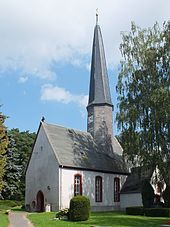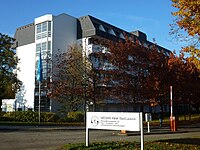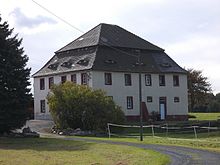Bad Lausick
| coat of arms | Germany map | |
|---|---|---|

|
Coordinates: 51 ° 9 ′ N , 12 ° 39 ′ E |
|
| Basic data | ||
| State : | Saxony | |
| County : | Leipzig | |
| Management Community : | Bad Lausick | |
| Height : | 164 m above sea level NHN | |
| Area : | 70.03 km 2 | |
| Residents: | 7984 (Dec. 31, 2019) | |
| Population density : | 114 inhabitants per km 2 | |
| Postal code : | 04651 | |
| Area code : | 034345 | |
| License plate : | L , BNA, GHA, GRM, MTL, WUR | |
| Community key : | 14 7 29 010 | |
| LOCODE : | DE BF6 | |
| City structure: | 12 localities | |
City administration address : |
Markt 1 04651 Bad Lausick |
|
| Website : | ||
| Mayor : | Michael Hultsch | |
| Location of the city of Bad Lausick in the Leipzig district | ||
Bad Lausick - also known as Laus'sch , officially Lausigk until 1913 - is a town in the Leipzig district in Saxony and the seat of the Bad Lausick administrative community . It has had the status of a spa town since 1913 (with the addition of "Bad" to its name) and is a state-recognized spa in the Free State of Saxony ( spa ).
geography
The small town is located in the middle of the Saxon castle and heathland , on the edge of the Colditzer Forest nature reserve, south of the city of Grimma (13 km), east of the district town of Borna (13 km) and west of Colditz (twelve kilometers). The Parthe rises in the Glasten district.
Local division
- Bad Lausick
- Ballendorf
- Beucha , first mentioned in 1180
- Buchheim , first mentioned in a document in 1384
- Ebersbach , first mentioned in a document in 1384
- Etzoldshain , first mentioned in 1104
- Glasten , first mentioned in a document in 1350
- Kleinbeucha , originated in the 18th century
- Lauterbach , first mentioned in a document in 1350
- Steinbach , mentioned for the first time in 1180
- Stockheim , first mentioned in 1204
- Thierbaum , first mentioned in a document in 1290
history
Development from the 11th to the 18th century
Bad Lausick was first mentioned in 1096 as "Luzke". The names "Luzic" (1181), "Luzich" (1219) and "Lußigk" (1414) appear in other documents. In 1497 the place was first referred to as "Laussigk".
In 1106 the construction of the St. Kilian Church started and a monastery was founded by Wiprecht von Groitzsch . In 1158 the place was designated as a fortified market town under the name "Luzeche" . In addition, a "Feste Lausick" ( Lausick Castle ) is mentioned alongside other castles and fortified royal courts in 1158 in a table goods directory of the royal state of Pleißenland under Friedrich Barbarossa . Lausigk has had a central role in the region since the 12th century. After the Treaty of Leipzig Laussigk belonged starting from 1485 to the Electorate of Saxony with its capital Wittenberg . Schools began operating for the first time in 1529.
In 1605 the town was granted town charter and in the same year the town was completely destroyed in a town fire. During the Thirty Years' War , the plague broke out in the village in 1633 and made it almost uninhabitable. Imperial troops sacked the city in 1637 and 1641. According to historical records, further city fires broke out in 1649, 1667, 1693 and 1719, which always left great damage. In the fire in 1693, the city was destroyed with the exception of 22 small houses, in 1719 only eight houses and 21 barns remained usable. The old schoolhouse in front of the church was first mentioned in 1736. In 1739 the old town hall and the tower of the church were built. In 1772 the city suffered from a great famine due to a bad harvest.
Changes due to lignite in the 19th century
Coal mining began around 1800 and the first lime kilns began production. Healing springs were discovered during lignite mining in 1820 . Just one year later, the Herrmannbad, named after its founder Gottlieb Friedrich Herrmann , opened the first spa . In 1840 the construction of a school with four classrooms for 500 students and four teacher's apartments began on Untermarkt. In 1867 the city had 3,456 inhabitants, including 250 mercenaries. 1878 is recorded in the annals as the heyday of coal mining and lime kilns in and around Lausigk. In Köllsdorf there were 36 pits and over 20 lime kilns. In 1882, following a council resolution, the Herrmannsbad became the property of the city and developed into an institution that was important to the town. On March 18, 1882, Johann Gottfried Becker founded the traditional textile company J. G. Becker in the city center. The construction of a new community school with 15 classrooms for 900 children began in 1886.
In 1887, Lausick was connected to the railway network with the construction of the Leipzig – Geithain railway line. In 1890 the place had 3977 inhabitants, in that year large archives were destroyed in a fire in the town hall. With 25 companies, the production of felt goods was in its prime. There were still eleven lignite works and five lime kilns . There were also 30 farms, in addition, the statistics recorded 20 bakeries, 25 shoemakers, 25 tailors, 17 weavers, 10 butchers and 43 other craftsmen as well as 23 restaurants.
From around 1895 the clay industry developed, from which the silicate factory later emerged. In 1897 the new town hall with post office was built. A year later a district court was built.
20th century
Since 1913, after more than 100 years of spa business, the city has been called Bad Lausick. In 1920, construction of the cross line began on the Bad Lausick– Großbothen section . In 1928 the Hermannsbad was redesigned and modernized. After the incorporation of Reichersdorf and Heinersdorf in 1935, the city had 5083 inhabitants. In 1937 the Bad Lausick– Neukirchen-Wyhra section was completed. Passenger trains have been running from Borna via Bad Lausick to Großbothen since October 1937 . Bad Lausick developed into a well-visited health resort. In 1939 a military hospital was set up in Hermannsbad , which existed there until 1945. The city was spared air raids during World War II and was not damaged by the war. From 1948, the cross line was dismantled as a reparation payment .
Bad Lausick belonged to the district of Geithain since 1951 and became the seat of the district court . A consumer country department store was opened on the market in 1956 as the largest shopping facility. In 1957 the original Romanesque condition of the St. Kilian Church could be restored, it received a Silbermann Trampeli organ from 1722. In 1958 the town had 7,449 inhabitants and celebrated the 800th year on the basis of a certificate from Friedrich I (Barbarossa) -Celebration. In the years up to 1962, what is now known as the “ iron vitriol and mud bath” was completely modernized. In 1964 the pedestrian tunnel replaced the dilapidated "Elephant Bridge" on Badstrasse, which was later replaced by a new bridge. In 1967 and 1968 the school on Frohburger Straße was expanded with eight classrooms and two specialist rooms. From 1972 the spa became a "sanatorium for cardiovascular diseases". VEB Heimschuh and VEB Mühlenwerke emerged from formerly semi-public companies . The agricultural production cooperatives (LPG) of Bad Lausick, Ballendorf, Buchheim and Ebersbach were merged in 1976 to form LPG Ernst Thälmann. In 1978 the LPG (P) Karl Liebknecht and the LPG (T) Ernst Thälmann were created. Between 1979 and 1988 the silicate plant was modernized and expanded. In 1987 the city celebrated the centenary of the Leipzig-Geithain railway line and in 1988 began the implementation of a complex housing project in the new district, which included 270 apartments, a school, a gym and a department store.
During the fall of the Berlin Wall, around 300 people demonstrated with candles and banners on October 25, 1989 after a prayer for peace. At the same time, a city council meeting took place at which the demonstrators put forward their demands and demonstrated against the SED. On November 7th, 1989 around 1000 citizens demonstrated in Bad Lausick and demanded reforms, travel payments and free elections on banners. On January 29, 1990, the second round table took place in Bad Lausick without representatives of the SED-PDS. It was about abuse of office and corruption, questions of security and construction projects. The mayor at the time offered to include representatives of the New Forum and the Social Democratic Party in the GDR (SPD) in the city council.
In 1995 the Kurhaus with Kurmittelhaus, the Kurhotel and the spa and leisure pool "RIFF" were opened. In 1996, due to the first mention in 1096, the 900th anniversary celebration was held. A new thermal water well was drilled two years later. The places Steinbach, Beucha, Kleinbeucha and Stockheim were incorporated in 1999. In 2005 the St. Kilian Church celebrated its 900th anniversary, the 8th State Harvest Festival and the 5th State Brass Music Festival took place in Bad Lausick. In 2008 a spa and city museum was set up. In August of the same year, the Muldental district was dissolved as part of a further district reform in Saxony and the place was assigned to the new district of Leipzig.
On September 20, 2011, a regional express on the Chemnitz-Leipzig route in the Lauterbach district derailed due to a collision with a car on the level crossing. 49 people were injured in the serious train accident.
The municipality covers an area of almost 70 square kilometers and has around 8,750 inhabitants, the spa is now the most important branch of the city again.
Incorporations
Already in 1840, 1935, 1967 and 1972 there were regional amalgamations in the area of the current city of Bad Lausick. In 1994 six formerly independent municipalities were incorporated. Thierbaum was reclassified from Nauenhain to Bad Lausick, Steinbach followed in 1999.
| Former parish or manor district | date | annotation |
|---|---|---|
| Ballendorf | March 1, 1994 | |
| Beucha | January 1, 1967 | Merger with Steinbach to Beucha-Steinbach |
| Beucha-Steinbach | 1st October 1972 | Merger with Stockheim zu Steinbach |
| Buchheim | January 1, 1994 | |
| Ebersbach | January 1, 1994 | |
| Etzoldshain | January 1, 1994 | |
| Glasses | January 1, 1994 | |
| Heinersdorf (with desert stone) | October 1, 1935 | |
| Koellsdorf | 1840 | |
| Lauterbach | January 1, 1994 | |
| Reichersdorf | October 1, 1935 | |
| State forest district Glasten, manor district | December 11, 1948 January 21, 1949 |
Partial integration according to Glasten Partial integration according to Ballendorf, Etzoldshain and Glasten in the course of the land reform |
| Steinbach | January 1, 1967 October 1, 1972 January 1, 1999 |
Merger with Beucha to Beucha-Steinbach, re-establishment, incorporation |
| Stockheim | 1st October 1972 | Merger with Beucha-Steinbach zu Steinbach |
| Thierbaum | January 1, 1974 January 1, 1994 |
Incorporation to Nauenhain , reclassification to Bad Lausick |
Population development
|
|
|
|
politics
City council
Since the municipal council election on May 26, 2019 , the 18 seats of the city council have been distributed among the individual groups as follows:
| Party / list | Seats |
| Independent voters' association (UWV) | 6 seats |
| AfD | 4 seats |
| CDU | 4 seats |
| LEFT | 3 seats |
| SPD | 1 seat |
mayor
- Michael Hultsch (independent); elected June 7, 2015, took office in August 2015
Town twinning
The Upper Franconian town of Baunach in Bavaria has been a twin town since 1990 .
economy
Spa facilities
In the course of lignite mining in 1820, healing water was found in the current grounds of the spa park. A year later, the spa operation began in the "Herrmannsbad", named after the discoverer of water, the magistrate Gottlieb Friedrich Herrmann. A cardiovascular sanatorium was later built from this bath. After the fall of the Wall, the spa was renamed "Herrmannsbadklinik", which was closed in 1993; the Kurhaus was demolished #. In 1995 the first guests were able to visit the new Kurhaus with Kurmittelhaus and Kurhotel, the newly built spa and leisure pool “Riff” and Haus Herrmannsbad (belonging to the neighboring Saxon Clinic). The open-air stage "Butterfly" is in the spa park on the site of the old spa house. The thermal water fountain "Aqua Vitales" was inaugurated in 2007. In December 2010, the city of Bad Lausick was re-rated as a spa.
Clinics
In 1993 two private rehabilitation clinics were opened, the Median Clinic for Cardiovascular Diseases and Orthopedics and the Saxony Clinic for Orthopedics, Neurology and Psychosomatics as a subsidiary of the Michels Clinics .
Other companies
- rotstahl GmbH - high quality steel furniture
- Kerma Verbandstoff GmbH, founded on April 4, 1886 in Lausick.
- Reuter & Schreck building cleaning, founded on April 1st, 1990
- BioSal Anlagenbau GmbH
- Jabitherm Rohrsysteme AG, Bad Lausick branch
- RWZ Solarenergie GmbH
- Textilhaus JG Becker OHG, founded on March 18, 1882
education
- Evangelical school for social affairs "Luise Höpfner" - seminar for church service, founded in 1953
- " Werner Seelenbinder " high school , founded in 1886
- Bad Lausick elementary school, founded in 1992
- The Saxon Wind Philharmonic and the German Wind Academy are based in Bad Lausick.
Sports
KSV Bad Lausick e. V. is a powerlifting club. Some of the athletes working here are members of the national powerlifting squad and regularly take part in national and international sporting events in powerlifting . The association was founded in 1982 and organizes a large number of competitions every year.
traffic
Bad Lausick is in the network area of the Central German Transport Association and is connected by the Leipzig regional bus and the THÜSAC local passenger transport company with a PlusBus and other regional bus routes. Furthermore, Bad Lausick has a train station on the Leipzig – Geithain railway line , which is served every hour by the regional express line RE6 Leipzig – Chemnitz and the regional train line RB113 Leipzig – Geithain. The federal highway 176 runs through the city.
Attractions
- Romanesque St. Kilian's Church with an organ built by Gottfried Silbermann for the Johanniskirche in Chemnitz in 1722 and expanded by Johann Gottlob Trampeli in 1792 .
- Spa and city museum
- RIFF leisure pool
- Spa park with open-air stage "Butterfly"
- Villa district Kurviertel in Art Nouveau style
- town hall
- Steinbach Church
- Steinbach Castle
- Manor house and half-timbered houses in glass
- Colditzer Forest
- Post windmills Ballendorf and Ebersbach
- Several post mile pillars, see Kursächsische Vollmeilensäule Bad Lausick , Kursächsische Halbmeilensäule Bad Lausick , Kursächsischer Viertelmeile Bad Lausick
sons and daughters of the town
- Friedrich Heinrich Wilhelm von Zollikofer (1737–1798), Prussian major general
- Karl Friedrich August Fritzsche (1801–1846), theologian
- Franz von Fleischer (1801–1878), botanist
- Friedrich Küchenmeister (1821–1890), physician and freemason
- Paul von Seydewitz (1843–1910), Saxon Minister of Education
- Ernst von Seydewitz (1852–1929), Saxon Finance Minister
- Walther von Witzleben (1865–1949), Saxon major general
- Herbert Albert (1903–1973), pianist and conductor
- Hannshubert Mahn (1903–1943), art historian
- Horst Winkler (1929–1987), pathological physiologist, anesthetist and intensive care physician
- Monika Reichardt (* 1956), politician (CDU) and member of the state parliament in Saxony
literature
- Franz Bauer: Bad Lausick. In: Sächsische Heimatblätter ( ISSN 0486-8234 ), year 1957, issue 5, pp. 339–341.
- Karlheinz Blaschke : Lommatzsch and Lausick. Two “church towns” in Saxony. In: Peter Johanek (ed., With the collaboration of Uwe John): Urban plan and urban development. Research into the development of central European cities. Selected essays by Karlheinz Blaschke . (= Urban research, series A, representations , volume 44.) Böhlau, Cologne / Weimar / Vienna 1997, ISBN 3-412-06897-7 , pp. 342–351. (2nd unchanged edition, 2001, ISBN 3-412-02601-8 )
- Johannes Christoph Cordes, Gottfried Becker, Walter Heimann: Bad Lausick. (= Tourist Wanderheft , Volume 31.) Tourist Verlag, Berlin / Leipzig 1983.
- Kur- und Verkehrsverein Bad Lausick (Ed.): Bad Lausick. Memories in pictures. Geiger Verlag, Horb am Neckar 1993, ISBN 3-89264-769-0 .
- Friedrich Pohl: The Hermannsbad near Lausigk not far from Leipzig. Wienbrack, Leipzig 1822. ( digitized )
- Rudolf Priemer, Peter Franke: Bad Lausick. The spa town and its surroundings. Sax-Verlag, Beucha 1997, ISBN 3-930076-32-2 .
- Bad Lausick City Council (ed.): 800 years of Bad Lausick. Festschrift on the occasion of the 800th anniversary from June 13 to 16, 1958. Bad Lausick 1958.
- City administration Bad Lausick (ed.): 900 years Bad Lausick 1096–1996. Sax-Verlag, Beucha 1996, ISBN 3-930076-31-4 .
- City history Bad Lausick (Hrsg.): History of the city Bad Lausick .
- Richard Steche : Lausigk. In: Descriptive representation of the older architectural and art monuments of the Kingdom of Saxony. 15. Issue: Amtshauptmannschaft Borna . CC Meinhold, Dresden 1891, p. 72.
- A record of the Lausick City Court for the period 1659-1833 on local administration, civil and voluntary jurisdiction, church and school matters and court books is in the Saxon State Archives, Leipzig State Archives, inventory 20609 City Lausick (City Court).
Web links
- City website
- Bad Lausick in the Digital Historical Directory of Saxony
Individual evidence
- ↑ Population of the Free State of Saxony by municipalities on December 31, 2019 ( help on this ).
- ↑ Announcement of the Saxon State Ministry for Economics, Labor and Transport on the change of the list of health and recreation places in the Free State of Saxony according to § 3 Abs. 5 SächsKurG from January 20, 2014
- ^ Walter Schlesinger , edited by Thomas Lang: "The historical prerequisites of the Glauchau city foundation", In: Contributions to the history of the city of Glauchau. Edited by Enno Bünz. Thelem Verlag, Dresden 2010, "Feste Lausick" p. 44.
- ↑ Michael Richter: The peaceful revolution. Departure to democracy in Saxony 1989–90. Volume 2, page 549, page 692 and page 1280.
- ↑ Regional express derailed in Saxony. In: Handelsblatt of September 20, 2011
- ↑ a b c d e f g h State Statistical Office of the Free State of Saxony: Area changes
- ↑ a b c d e municipalities 1994 and their changes since 01.01.1948 in the new federal states , Metzler-Poeschel publishing house, Stuttgart, 1995, ISBN 3-8246-0321-7 , publisher: Federal Statistical Office
- ↑ a b The Book of Saxony. Kommunal-Verlag Sachsen KG, Dresden 1943
- ↑ Landtag files from the years 1869–1870, supplement to the third section, 1st volume, 1st part, page 283
- ↑ a b lists of the municipalities incorporated since May 1945 and evidence of the subdivision of the independent manor districts and state forest districts, 1952, published by the Ministry of the Interior of Saxony
- ↑ Results of the 2019 municipal council elections
- ^ Spa history of the city of Bad Lausick
- ↑ Contact , Saxon Wind Philharmonic
- ^ Organ portrait ( memento from May 17, 2014 in the Internet Archive ) on the website of the Gottfried Silbermann Society, accessed on April 9, 2013.
- ↑ [1]
- ↑ Eckart Roloff , Karin Henke-Wendt: Anyone who wanted to get fit was strapped in. (Das Kur- und Stadtmuseum Bad Lausick) In: Visit your doctor or pharmacist. A tour through Germany's museums for medicine and pharmacy. Volume 1, Northern Germany. Verlag S. Hirzel, Stuttgart 2015, pp. 177-179, ISBN 978-3-7776-2510-2
- ^ City of Lausick (City Court). In: State Archives Leipzig. Retrieved March 26, 2020 . (Info text on Bad Lausick City Court under "Introduction")


















